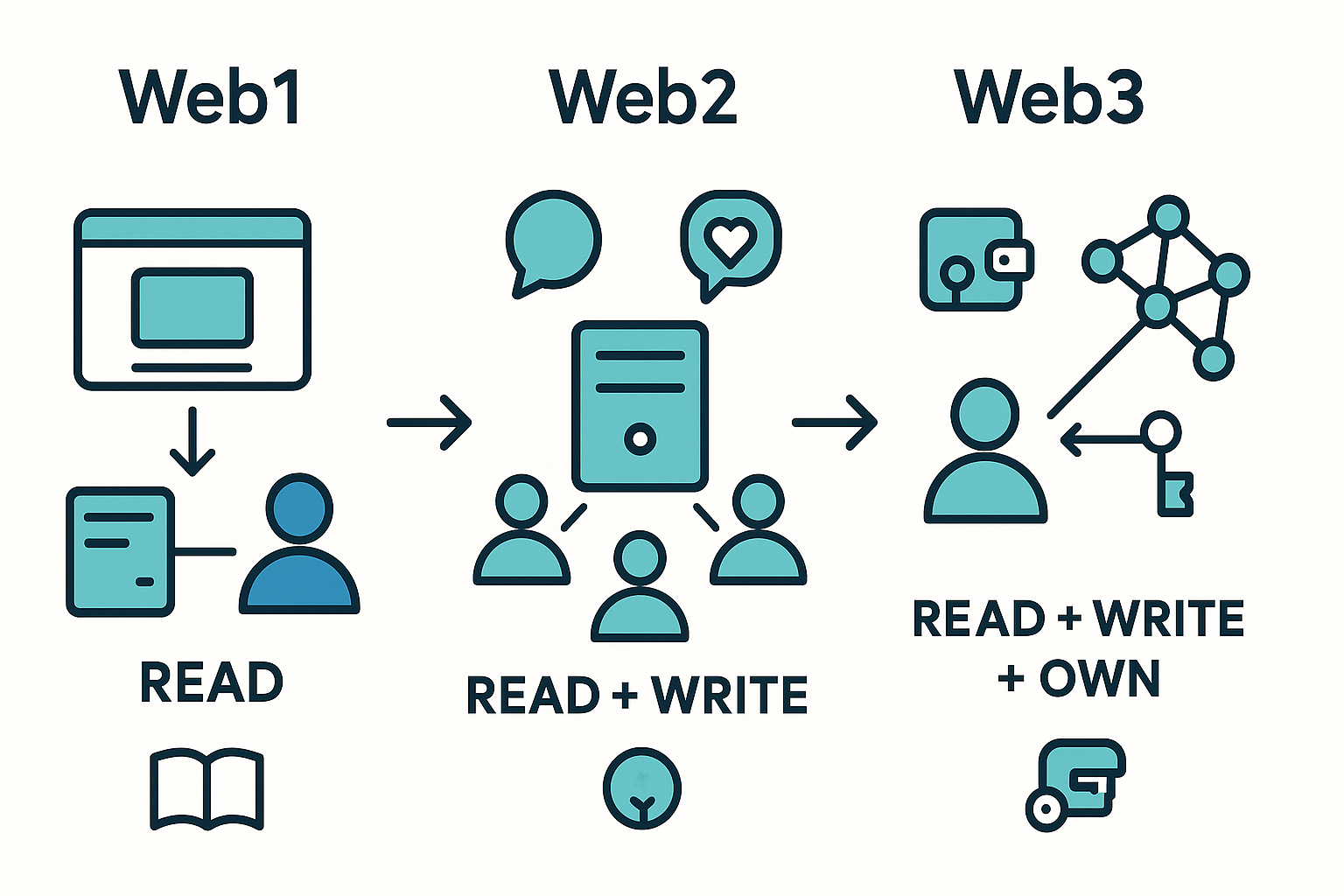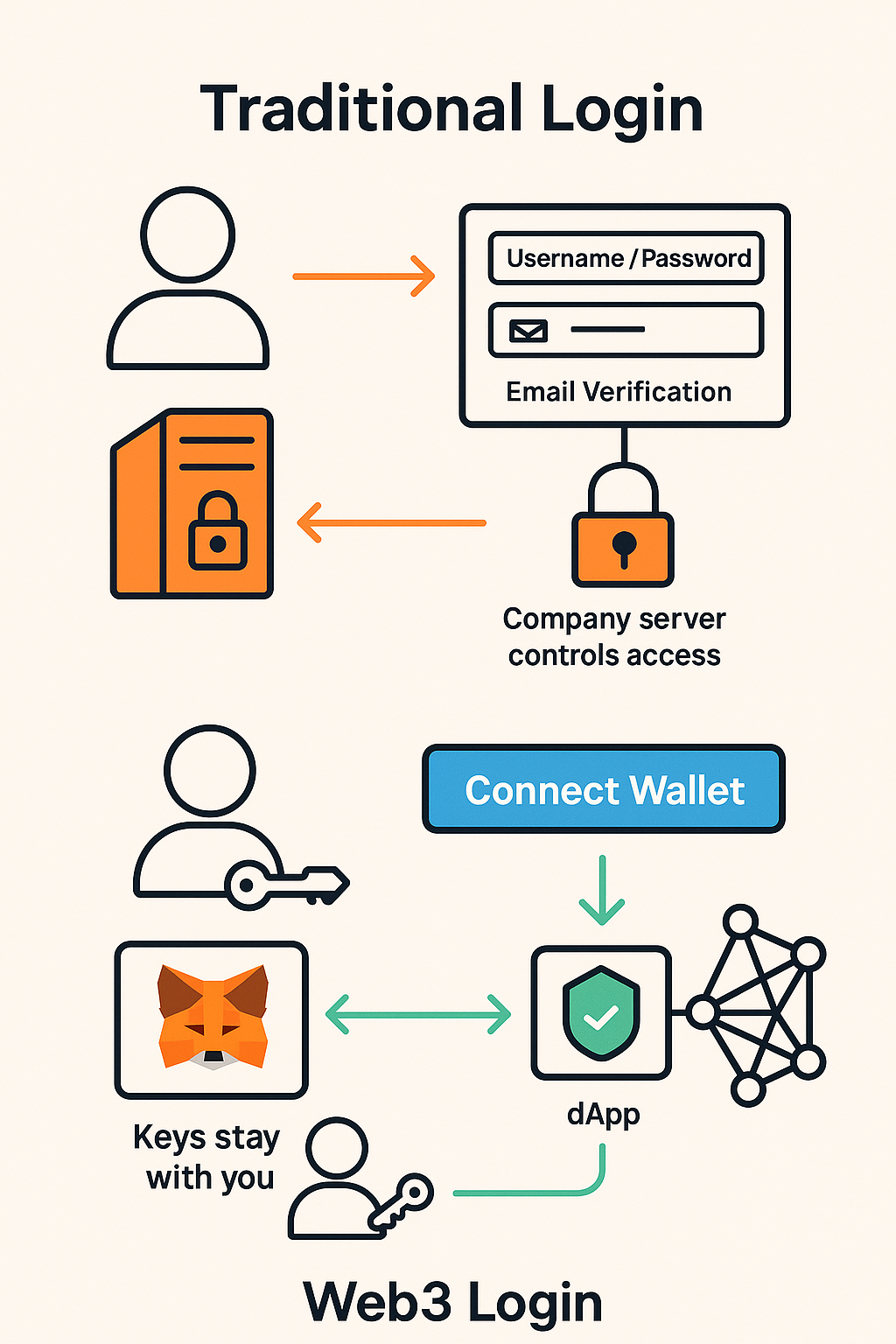What is Web3 Ownership Wallets and Decentralized Apps
In this module, we’ll explain Web3, often described as the “next generation of the internet.” In simple terms, Web3 refers to an internet that you can own a piece of. It’s built on blockchain technology and controlled by users rather than big companies. To understand Web3, it helps to compare it with earlier stages of the web:
⚠️ Educational Disclaimer: This course is for educational purposes only and does not constitute investment advice. Always do your own research before making financial decisions.
- Web1 (the early internet) was mostly read-only, static websites where you could consume information.
- Web2 (the current internet) is read-write, interactive platforms like social media, where you can create content, but large companies (like Google, Facebook, etc.) control the platforms and your data.
- Web3 is read-write-own – you not only interact but also own your data and assets on the platform. Instead of a few corporations in charge, Web3 platforms are decentralized and often governed by communities of users.
Common Misconceptions about Web3
- “Web3 is anonymous.” Not really. Most public blockchains are pseudonymous: addresses aren’t names, but transactions are public and permanent, and on-chain activity can often be analyzed and linked.
- “Everything in Web3 is decentralized.” Many projects start more centralized and decentralize over time (“progressive decentralization”). Always check who controls the keys, upgrades, front-end, and governance.
- “A wallet is the same as an exchange account.” A self-custody wallet means you control keys. An exchange account is typically custodial, the company holds assets for you (useful, different trade-offs).
- “Connecting a wallet is risk-free.” DApps request permissions; sign only what you understand and regularly review/trim granted approvals.

Ownership and Wallets: A core idea of Web3 is that you hold ownership of your digital stuff through cryptographic wallets. A crypto wallet isn’t just for money – it’s like your digital passport for Web3. It holds your cryptocurrencies and other digital assets (like collectibles or game items), and it also serves as your identity for logging into Web3 apps. For example, rather than creating an account with a username and password, a Web3 application might simply ask you to connect your wallet. With that, you prove “I control this address” and you’re in – no email or third-party needed. You alone possess the private keys to your wallet, which means you (and only you) control the assets in it. This user-controlled identity is very different from Web2, where your account could be blocked or your data deleted by a company. In Web3, as long as you keep your keys safe, you truly own your digital assets and identity.
Popular Wallets at a Glance (and what they’re best for)
The “best” wallet depends on which chains you use, your device, and whether you prefer mobile or browser. Here are five widely used, general-purpose options:
MetaMask (browser, mobile)
Best for: EVM chains (Ethereum, Polygon, Arbitrum, etc.), broad dApp compatibility, extensions + mobile.
- Notable: Reported 30M+ MAUs in early 2024; added default security alerts.
Trust Wallet (mobile, browser extension)
Best for: Simple multi-chain mobile experience; supports 100+ blockchains; strong all-rounder for newcomers.
- Notable: Team communications highlight a large user base and multi-chain support; verify claims as figures can be marketing-led.
Phantom (mobile, browser)
Best for: Solana-first experience with fast swaps and NFT workflows; now multi-chain (Solana, Ethereum, Bitcoin, others).
- Notable: Reported ~10M MAUs in 2024 (official year-in-review).
Coinbase Wallet (mobile, browser extension)
- Best for: Self-custody with easy bridges into the Coinbase ecosystem; solid support for Ethereum, Base, Optimism, Polygon, and Solana NFTs; friendly set-up/import.
Gate Wallet (mobile, web3 portal)
- Best for: Multi-chain wallet with a dApp hub, airdrops and task pages aimed at on-chain exploration. Good if you’re already in the Gate ecosystem.
Tip: Regardless of wallet, learn how to back up your recovery phrase, verify dApp permissions, and consider using separate wallets for experimenting vs. holding larger balances.
To make this concrete, think of a Web3 wallet like MetaMask: a popular browser and mobile wallet app. When you use MetaMask to visit a Web3 site (say, a decentralized game or marketplace), the site asks MetaMask for permission to connect, and with a couple of clicks, you’re logged in and ready to use the app. No one asks for your name or phone number; your wallet address is your identity. Already, tens of millions of people use such wallets – MetaMask alone surpassed 30 million monthly active users by early 2024 – showing that a growing number of users are embracing this new way to access online services.

Decentralized Apps (dApps): Web3 is powered by decentralized applications, or dApps. These are apps that run on blockchain networks instead of centralized servers. In a dApp, the important logic and data live on a blockchain (often through smart contracts, which are self-executing programs on the blockchain). This means no single company has ultimate control over the app; it’s governed by code and often by its user community. dApps can look and feel like the apps you’re used to – there’s usually a normal website or interface – but behind the scenes, they interact with blockchain smart contracts.
What can you do with dApps? There are already many examples: you can use decentralized finance services (DeFi) to lend or swap crypto without a bank, play games where in-game items are blockchain tokens you truly own, join social networks where your profile and content live on decentralized storage, and much more. For instance, Uniswap is a dApp that lets you trade tokens directly with a smart contract (no centralized exchange needed), and OpenSea is a dApp marketplace for non-fungible tokens (NFTs) where users buy and sell digital collectibles. We won’t dive deep into DeFi or NFTs here (you might have touched on them in earlier courses), but these are good examples of Web3 in action. The key point is that Web3 apps give you more control and ownership. When you buy a digital item in a Web3 game, it’s your asset in your wallet – not just a line in a game database that could be wiped. When you participate in a Web3 social platform, you might even earn tokens that give you a stake in the network’s governance or value.
It’s important to note that Web3 is still an evolving idea. Not everything that calls itself “Web3” is fully decentralized or perfect. However, the general vision is an internet where ownership is central: users own their data, their digital goods, and even a stake in the platforms themselves. This is made possible by blockchain technology enabling scarce digital assets (like cryptocurrencies and NFTs) and by decentralization ensuring no single party can take away or censor those assets arbitrarily. In summary, Web3 is about empowering you, the user, in the online world – giving you direct control, privacy, and a way to benefit from the growth of platforms, rather than just being the product of big tech companies.
By understanding Web3’s principles of ownership, wallets, and dApps, you’re getting a glimpse of how the internet is being reimagined. Next, we’ll explore the Metaverse – a concept that often goes hand-in-hand with Web3 – to see how these ideas translate into virtual worlds and experiences.





